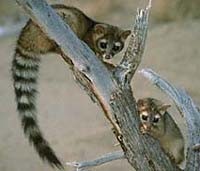
Leopard
Everybody knows what a cat is, once you have seen a single adult cat you can instantly recognise nearly every other species as being closely related. The possible exceptions to this are the Jaguarundi and the Manul as well as the Flat-headed Cat and perhaps the Kodkod, however once you look closely at even these exceptional species you soon see their cat genes at work. A house cat, although small and domesticated, is a Jaguar, a Tiger or a Leopard in miniature, their beauty, grace and fluidity of movement have brought great joy to mankind for thousands of years. Read more at EarthLife

Tiger
Big Cats Facts
- The cheetah is the world's fastest land mammal. It can run at speeds of up to 70 miles an hour (113 kilometers an hour).
- An adult lion's roar can be heard up to five miles (eight kilometers) away.
- Long, muscular hind legs enable snow leopards to leap seven times their own body length in a single bound.
- A tiger's stripes are like fingerprints—no two animals have the same pattern.
- The strongest climber among the big cats, a leopard can carry prey twice its weight up a tree.
- The Amur leopard is one of the most endangered animals in the world.
- In one stride, a cheetah can cover 23 to 26 feet (7 to 8 meters).
- The name "jaguar" comes from a Native American word meaning "he who kills with one leap."
- In the wild, lions live for an average of 12 years and up to 16 years. They live up to 25 years in captivity.
- The mountain lion and the cheetah share an ancestor.
- Cheetahs do not roar, as the other big cats do. Instead, they purr.
- Tigers are excellent swimmers and do not avoid water.
- A female Amur leopard gives birth to one to four cubs in each litter.
- Fossil records from two million years ago show evidence of jaguars.
- Lions are the only cats that live in groups, called prides. Every female within the pride is usually related.
- The leopard is the most widespread of all big cats.
- Mountain lions are strong jumpers, thanks to muscular hind legs that are longer than their front legs.
- Tigers have been hunted for their skin, bones, and other body parts, used in traditional Chinese medicine.
- Unlike other cats, lions have a tuft of hair at the end of their tails.
- After humans, mountain lions have the largest range of any mammal in the Western Hemisphere.
Mammals in the cat family are found in cold and warm climates except for Australia and Antarctica.
Felines have very characteristic eyes. Most vertebrates have eye muscles that, in strong light, close the pupil to a small round hole. Cats have eye muscles that pull the sides of the iris together until only a small slit shows.

A feline's eyes are so sensitive that during the day a tiny crack is sufficient for seeing. At night the muscles relax and the pupil becomes large and round. Faint rays enter making it possible for the cat to see form and indistinct outlines.
A cat's claws differ from most other animals because they are retractable.

The most common wild cat in the United States is the bobcat. Defenders of Wildlife Bobcat Fact Sheet

The only unspotted wild cat in the United States is the adult cougar, also known as a mountain lion, puma, and panther. Unlike the bobcat and lynx, it has no ruffle at its neck, nor does it have any sort of mane. it is light in color on the insides of the legs and underneath. On the cheeks, the tips of the ears, and the end of the tail are blackish markings. it has clear, yellow eyes, big heavy whiskers, and a long, round tail. Read more at the Washington Dept. of Fish and Wildlife

Jaguars are larger and heavier than cougars and are covered from face to tip of tail with markings called rosettes. Rosettes are rings, sometimes with spots in the middle. The ground color of a jaguar's coat is yellowish or buff, and the rosettes are dark-brown or black, enclosing a slightly darker color and an occasional black center spot. Read more about jaguars at National Geographic

A ringtail cannot fully retract its claws. There are 5 toes on both front and hind feet. It lives at altitudes up to 6,000 feet and is an excellent climber, as well as having the ability to jump across expanses of up to 10 feet. It's main predator is the owl.

The raccoon is another nighttime creature, but more commonly seen and known to man. The black mask covering the eyes and cheeks, and the bushy tail with its 4-7 dark bands make it distinctive in appearance. The soles of a raccoon's feet are bare, and unlike other mammals that walk only on their toes, the raccoon walks fully on its feet. Its claws cannot be pushed out and pulled in like those of other cats. The raccoon swims well and is at home in water as well as trees. Read more about raccoons at PBS/Nature
Cats lapbook at HomeschoolShare
Tiger lapbook at HomeschoolShare
Felidae Conservation Fund list of cat species
No comments:
Post a Comment